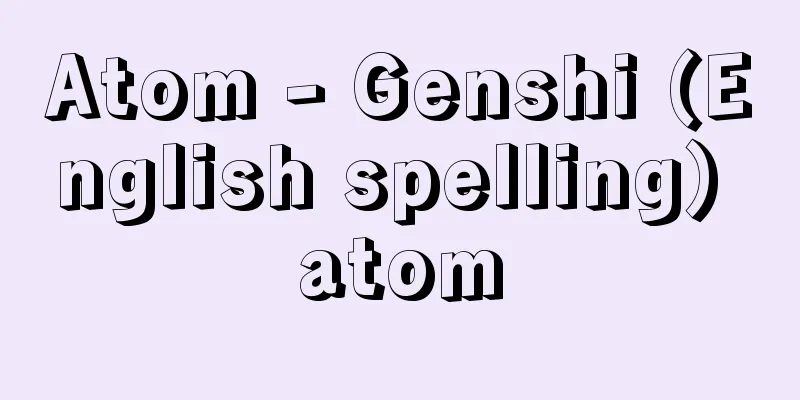Atom - Genshi (English spelling) atom

|
A basic unit particle of matter that cannot be divided any further by normal chemical methods. It is electrically neutral. The origin of the word atom is said to be the Greek atmos (ατομοζ), which means "indivisible". In reality, an atom is composed of a positively charged nucleus and a number of electrons to cancel out the positive charge, and the nucleus is further composed of several protons and neutrons. Neutrons have no charge, so the charge of the nucleus is due to protons. Therefore, atoms are no longer particles that cannot be divided any further. However, if an atom is divided any further, it will lose its chemical properties, so it is the smallest particle in terms of maintaining its chemical properties. The most basic components that make up matter in nature are called elementary particles, and they can be thought of as being truly indivisible. The size (diameter) of an atom is about 10 -10 meters (1 Å. Å is angstrom), but the size of an atomic nucleus is very small, about 10 -14 meters. In other words, if the nucleus were a baseball with a diameter of about 7 centimeters, the atom would be about 700 meters long, enough to easily fit an entire baseball field. On the other hand, the mass of the nucleus is very large compared to the mass of the electron. For example, the nucleus of a hydrogen atom consists of only one proton and has a mass of about 1.67× 10-27 kilograms, while the mass of the electron is only 1/1836 of that. [Yasuhiro Sakai, August 21, 2017] Atoms and ElementsThere is a word similar to atom called element, but element is a concept and a general term for atoms with the same chemical properties. The chemical properties of an atom are mostly determined by the number of electrons, i.e. the number of protons, of the atom, so the periodic table used in chemistry is organized by atomic number, which indicates the number of protons (i.e. the number of electrons). Atoms with the same atomic number can have different numbers of neutrons, and these are called isotopes. The general term for these is element. For example, the element hydrogen exists in nature in forms with 0, 1, and 2 neutrons, and are called hydrogen (also called protium), heavy hydrogen (deuterium), and tritium (tritium), respectively, but each has the same chemical properties. It is said that 92 elements exist in nature, from hydrogen (atomic number 1, H) to uranium (atomic number 92, U). However, four elements, technetium Tc (atomic number 43), promethium Pm (atomic number 61), astatine At (atomic number 85), and francium Fr (atomic number 87), are found in extremely small quantities in nature. As of the end of 2016, elements artificially created through nuclear reactions (transuranium elements) up to atomic number 118 have been synthesized, and their names and symbols have been officially recognized by the International Union of Pure and Applied Chemistry (IUPAC). Of these, element 113 was first synthesized and discovered in 2004 (Heisei 16) by an experimental group led by Kosuke Morita (1957-) of the Superheavy Element Research Group at the Nishina Accelerator Research Center of the Institute of Physical and Chemical Research (RIKEN). After successfully synthesizing the third element in 2012, it was recognized as a new element in December 2015 and the right to name it was acquired. At the end of November 2016, the proposed name nihonium and element symbol Nh were officially recognized. To date, no group has discovered an element outside of Europe or the United States, and this is the first time in Asia that a new element originating from Japan has been officially recognized and named. Looking back at the history of chemistry, long before the discovery of this new element, in 1908 (Meiji 41), Masataka Ogawa (1865-1930) of Tohoku University announced the discovery of element with atomic number 43 and named it nipponium. However, this discovery was later cancelled, and the symbol "Np" that was planned to be used for the element was used for neptunium (element number 93). Element number 43 was discovered by American physicist Segre in 1936, and named technetium in 1947. It is currently believed that the element discovered by Ogawa was rhenium (element number 75). At the time, rhenium was an undiscovered element, and Ogawa could be said to be its phantom discoverer. In fact, neptunium, which was given the symbol "Np," was also indirectly discovered by Yoshio Nishina of RIKEN in 1940 (its discovery was not recognized because it could not be isolated), so it is a strange coincidence that nihonium was discovered by the RIKEN experimental team named after Nishina. [Yasuhiro Sakai, August 21, 2017] Mass Number and Atomic Weight The sum of the number of protons and the number of neutrons is called the mass number. Therefore, the aforementioned isotopes can be said to have the same atomic number but different mass numbers. Those with the same mass number but different atomic numbers are called isobars. When it is necessary to indicate the mass number, it is written with a subscript such as 1H , and when the atomic number is also written, it is written as. The mass number is approximately equal to the mass of the atom expressed in unified atomic mass units. The unified atomic mass unit is defined as 1/12 of the atomic mass of the carbon isotope 12C , which has a mass number of 12, and its unit is (u). The atomic weight, which is written for each element in the periodic table along with its atomic number, is an indicator of the average mass of the element. Since naturally occurring elements are mixtures of several isotopes with different mass numbers, the atomic weight is expressed as the sum of the mass numbers of the isotopes multiplied by the abundance ratio, and is not necessarily an integer value. In addition, atomic weight has no unit. For example, naturally occurring carbon has mass numbers 12, 13, and 14. The abundance ratios of these isotopes are 12 C (98.9%), 13 C (1.1%), and 14 C (0.0%), so the atomic weight of carbon is: [Yasuhiro Sakai, August 21, 2017] Atomic StructureThe electrons in an atom may be thought of as orbiting around the nucleus. The orbital motion of a negatively charged electron around a positively charged nucleus due to the electrostatic attraction between them reminds us of the motion of planets in the solar system, but the difference is that the electron is a charged particle. In the case of the sun and the planets, they are attracted to each other by their mutual gravitational force, which means that they have acceleration in the direction of the sun. If left alone, the planets would be pulled into the sun, but the centrifugal force generated by the planets' rotation around the sun allows them to maintain their orbital radius. The rotation of electrons around the nucleus seems to be a similar phenomenon. However, according to the electromagnetism of British physicist Maxwell, charged particles that accelerate radiate electromagnetic waves and lose kinetic energy every moment, so they are attracted toward the nucleus and the orbital radius shrinks. As a result, the atom collapses in an extremely short time (about 10 -11 seconds). Of course, this is not the case, and atoms exist stably at a certain size, so the theory of classical physics cannot explain this contradiction. Also, unlike the motion of planets, it is known that electrons in atoms are not allowed to move in any orbit, but can only take discrete states of motion (discrete steady states) determined by the type of atom. This is called quantization, and the discrete steady states of quantized electrons in atoms are called the electronic structure or electronic state of the atom. In addition, their energy is called the energy level. Classical physics cannot explain why the energy of electrons in atoms is quantized, and quantum mechanics is needed to describe the tiny world of atoms. [Yasuhiro Sakai, August 21, 2017] The Framework of Quantum MechanicsShortly after Rutherford established the existence of the atomic nucleus and proposed the atomic model in the early 20th century, Bohr proposed a theory (classical quantum theory) that combined classical mechanics and the idea of energy quanta by assuming the quantum condition that only electron orbits with a specific angular momentum are allowed in atoms, and succeeded in explaining many phenomena related to atomic spectra. However, to understand the mechanics of the microscopic world in a unified way, we had to wait for the emergence of quantum mechanics, which was independently constructed by Heisenberg and Schrödinger in 1925, following the concept of matter waves by Einstein and de Broglie and the interpretation of wave functions by Born. Light is a type of electromagnetic wave, but when it interacts with matter, it behaves quantum-like, as in the case of the photoelectric effect. Microscopic particles such as electrons also have wave properties, as seen in electron diffraction. In the 20th century, it became known that all microscopic matter has the dual nature of particle and wave. In contrast to classical mechanics, in quantum mechanics, the state of electrons in atoms is represented by a wave function (state function), and mechanical quantities such as energy and momentum are represented by operators that act on the wave function. The relationship between these quantities is expressed by the fundamental equation, Schrödinger's wave equation. The possible values of energy and other physical quantities are found as eigenvalues of the equation when appropriate boundary conditions are imposed on the wave equation. The solutions of the wave function corresponding to each energy eigenvalue are called eigenfunctions. The probability of finding an electron at each point in space is given by the square of the wave function. In this way, in quantum mechanics, the location of an electron at a given time is not uniquely determined, but only the probability is determined. Therefore, it is incorrect to think of a fixed orbit as in classical mechanics to represent the state of motion of an electron within an atom; it is more appropriate to draw an image like an electron cloud expressed by the square of the state function. The shade of the cloud indicates the probability of finding an electron at that location. Quantum mechanics makes it possible to accurately calculate, within a consistent theoretical system, the steady-state energy values that an atom can assume, and the likelihood of transitions between energy levels occurring when an atom absorbs or emits light. [Hiroshi Suzuki] Atomic electron shell structure A set of four quantum numbers is usually used to specify the stationary states of an electron in an atom. The principal quantum number n determines the approximate magnitude of the energy. The order of energy from lowest (highest binding energy) to highest is n = 1, 2, 3, …. The azimuthal quantum number l represents the magnitude of the angular momentum of the electron, and the eigenstates are usually represented by the symbols s, p, d, and f corresponding to l = 0, 1, 2, 3, …. States with a single angular momentum are further distinguished by the magnetic quantum number m l (the quantum number representing the z component of angular momentum). The permissible values of m l for a given l state are - l , - l + 1, …, 0, …, l - 1, l In the ground state, electrons in an atom occupy orbitals from the lowest energy to the innermost. However, there is a law called the Pauli exclusion principle, which means that one quantum state cannot be occupied by more than one electron. Therefore, as the number of electrons in an atom increases, they are packed into orbitals from the lowest energy to the innermost. The capacity of each orbital is set as follows: 2 for 1s (spin +1/2 and -1/2), 2 for 2s, 6 for 2p ( the l = 1 orbital is divided into three levels due to the difference in the magnetic quantum number), 2 for 3s, 6 for 3p, and 10 for 3d ( the l = 2 orbital is divided into five levels due to the difference in the magnetic quantum number). States with the same principal quantum number can be treated as a single energy, so they are classified as the same electron shell. Shells with n of 1, 2, 3, 4, and 5 are called the K, L, M, N, and O shells, respectively. The number of states contained in each shell is 2 for the K shell, 8 for the L shell, and 18 for the M shell. [Hiroshi Suzuki] Atomic Electron Shell Structure and Chemical PropertiesWith the above shell structure in mind, it is easy to understand why the various chemical properties of elements change according to the periodic law. In rare gas elements such as helium (He), neon (Ne), and argon (Ar), the K, L, and M subshells (up to the 3p orbital) are filled with electrons, making them the most chemically inactive. In alkali metals such as lithium (Li), sodium (Na), and potassium (K), there is only one s electron in the outer shell of a closed shell, so the ionization energy (the energy required to remove one electron) is particularly small, and they tend to donate an electron to other atoms to become positive ions. On the other hand, halogen elements such as fluorine (F), chlorine (Cl), and bromine (Br) are one electron short of forming a closed shell like rare gas atoms, so they tend to gain an electron and become monovalent negative ions. Typically, the number that indicates how many specific atoms (hydrogen atoms are taken as the standard, with 1) an atom of a certain element bonds with is called atomic valence, and is the basis for considering the mechanism by which bonds are formed between atoms. However, atomic valence is determined by the number of electrons (valence electrons) in the atom's outermost shell that take part in chemical reactions. [Hiroshi Suzuki] Binding energy of electrons in atomsThe energy extracted from nuclear reactors using uranium or plutonium is generally called atomic energy, but this is easily misunderstood. The energy of a nuclear reactor is generated by nuclear fission, so it is more correct to call it nuclear energy. The energy of an atom is closer to the energy of a chemical reaction. The energy required to remove the outermost electron from an atom is called the minimum ionization energy. The largest value is 24.58 electron volts for helium, and the smallest is 3.9 electron volts for cesium. An electron volt is the energy acquired by a particle with an elementary charge when accelerated by a potential difference of 1 volt, and is equivalent to approximately 1.6×10 -19 joules. The electrons in an atom are bound with the highest energy in the innermost shell (K shell). Among naturally occurring elements, the K shell electrons of uranium have the highest energy, about 116,000 electron volts. Knowledge of the energies of these inner shell levels can be obtained from measurements of the element's characteristic X-rays and X-ray photoelectron spectra. [Hiroshi Suzuki] "Quantum Mechanical World View" (Tomonaga Shinichiro Collected Works 8, 1982, Misuzu Shobo) ▽ "From X-Rays to Quarks: Physicists of the 20th Century, by Emilio Segre, translated by Kubo Ryogo and Yazaki Yuji (1982, Misuzu Shobo)" ▽ "Atomic Spectra and Atomic Structure, by G. Herzberg, translated by Hori Takeo (1988, Maruzen)" ▽ "Nagashima Junkiyo, Fundamentals of Elementary Particle Physics 1" (1998, Asakura Shoten ) ▽ "Atomic and Molecular Physics, by Takayanagi Kazuo, edited by Arafune Jiro, Ezawa Hiroshi, Nakamura Koichi, and Yonezawa Fumiko (2000, Asakura Shoten)" ▽ "Takada Kenjiro, An Easy-to-Understand Introduction to Quantum Mechanics: Solving the Mysteries of the Atomic World" (2003, Maruzen)" ▽ "Yoshihara Kenji, "On Ogawa Masataka's Research on Nipponium" (Chemistry and Industry, Vol. 66, No.7, pp.538-540, 2013, Chemical Society of Japan)』 ▽ 『The Atom, by Jean Perrin, translated by Tamamushi Bunichi (Iwanami Bunko)』 [References] | | | | | | | | | | | | | | | |©Shogakukan "> The building blocks of atoms Source: Shogakukan Encyclopedia Nipponica About Encyclopedia Nipponica Information | Legend |
|
通常の化学的な方法ではそれ以上分割できない物質の基本的な構成単位粒子。電気的には中性である。原子の語源はギリシア語で「分割できない」という意味のアトモス(ατομοζ)であるといわれる。実際には、原子は正の電荷をもつ一つの原子核と、その正電荷を打ち消すだけの数の電子から構成され、さらに原子核はいくつかの陽子と中性子からなる。中性子は電荷をもたないために原子核の電荷は陽子によるものである。そのため原子は、これ以上分割できない粒子ではすでにない。しかし、原子をそれ以上に分割すると化学的な性質を失うので、化学的性質を維持するという点では最小の構成粒子である。自然界の物質を構成するもっとも基本的な構成要素は素粒子とよばれ、それはまさにそれ以上に分割できないものと考えてよい。原子の大きさ(直径)はおよそ10-10メートル(1Å。Åはオングストローム)であるが、原子核の大きさは10-14メートル程度と非常に小さい。つまり、原子核を直径約7センチメートルの野球ボールとすれば、原子は約700メートルにあたり、野球場全体が優に入るほどの大きさとなる。一方、原子核の質量は電子の質量に比べて非常に大きい。たとえば、水素原子の原子核は陽子1個だけからなり、その質量は約1.67×10-27キログラムであるが、電子の質量はその1836分の1にすぎない。 [酒井康弘 2017年8月21日] 原子と元素原子に似たことばに元素があるが、元素は概念であり、同じ化学的性質をもつ原子の総称である。原子の化学的性質は、ほとんどその原子の電子数すなわち陽子の数により定まるので、化学で用いられる周期表は、陽子の数(すなわち電子の数)を示す原子番号によって整理されている。同じ原子番号をもつ原子でも中性子の数が異なるものが存在し、それらはアイソトープ(同位体)とよばれる。これらの総称が元素ということになる。たとえば、元素としての水素には中性子の数が0、1、2個のものが自然界に存在し、それぞれ水素(軽水素、プロチウムともいわれる)、重水素(ジュウテリウム)、三重水素(トリチウム)とよばれるが、それぞれの化学的性質は同じである。 自然界には、原子番号1番の水素Hから92番のウランUまでの92種の元素が存在するといわれている。ただし、テクネチウムTc(43番)、プロメチウムPm(61番)、アスタチンAt(85番)、フランシウムFr(87番)の4種は、自然界の存在量がきわめて少ない。原子核反応により人工的につくられる元素(超ウラン元素)としては、2016年末の時点で原子番号118までが合成され、それらの名前と記号が国際純正・応用化学連合(IUPAC:International Union of Pure and Applied Chemistry)によって正式に認められている。 このうち113番元素は、日本の理化学研究所(理研)仁科(にしな)加速器研究センター超重元素研究グループの森田浩介(1957― )らの実験グループにより、2004年(平成16)に初めて合成され発見されたものである。その後2012年に3個目の合成に成功したことを受けて、2015年12月にそれが新元素であると認定され、命名権を獲得した。2016年11月末に提案通りの元素名ニホニウムnihonium、元素記号Nhが正式に認められた。これまでに、欧米以外の国で元素を発見したグループはなく、日本発の新元素の正式な認定と命名はアジア初である。化学史をひもとくと、今回の新元素発見のはるか昔、1908年(明治41)に東北大学の小川正孝(まさたか)(1865―1930)が原子番号43番の元素を発見したと発表し、ニッポニウムnipponiumと名づけたことがある。しかし、のちにこの発見は取り消され、元素記号として使う予定であった「Np」もネプツニウム(93番)に使われた。また、43番元素は1936年にアメリカの物理学者セグレにより発見され、1947年にテクネチウムと命名された。現在、小川の発見した元素はレニウムRe(75番)であったと考えられている。当時レニウムは未発見の元素であり、小川はその幻の発見者であったといえる。実は、「Np」の記号が与えられたネプツニウムも1940年に理研の仁科芳雄(よしお)により、間接的にではあるがみいだされており(単離できなかったことで発見が認められなかった)、仁科の名前を冠した理研の実験チームによってニホニウムが発見されたことは、奇妙な縁といえよう。 [酒井康弘 2017年8月21日] 質量数と原子量陽子の数と中性子の数の和は質量数とよばれる。したがって前述のアイソトープ(同位体)は、同じ原子番号でも質量数の異なるものともいえる。同じ質量数で原子番号の異なるものはアイソバー(同重体)とよばれる。質量数は、それを示す必要があるときには1Hのように添え字で表され、原子番号も併記するときにはのように書かれる。質量数は、統一原子質量単位で表した原子の質量と近似的に等しい。統一原子質量単位は、質量数が12である炭素同位体12Cの原子質量の12分の1と定義され、単位はユニット(u)である。周期表中の各元素に原子番号とともに書かれている原子量は、元素の平均的な質量を表す指標である。天然に存在する元素は質量数の異なる数種の同位体の混合物であることから、原子量はその同位体の質量数と存在比をかけて和をとった数として表したものであり、かならずしも整数値とはならない。また、原子量に単位はない。たとえば、天然に存在する炭素には質量数12のものと13および14のものがある。それぞれの同位体存在比は、12C(98.9%)、13C(1.1%)、14C(0.0%)であるので、炭素の原子量は、 [酒井康弘 2017年8月21日] 原子の構造原子内の電子は原子核の周りを飛び回っているとしてよい。負の電荷をもつ電子が、正の電荷をもつ原子核の周りを両者の間に働く静電的な引力によって軌道運動を行うことは、太陽系における惑星の運動をイメージさせるが、電子が荷電粒子であるという点が異なる。太陽と惑星の場合、両者は互いの引力によって引き合うが、それはつまり太陽の方向に加速度をもつということに対応する。そのままでは惑星は太陽に引き込まれてしまうが、惑星は太陽の周りを回転することで生じた遠心力によって軌道半径を維持できる。原子核の周りを電子が回転するということは、同様の現象のように思える。しかし、イギリスの物理学者マクスウェルの電磁気学によると、加速度運動する荷電粒子は、電磁波を放射し刻々と運動エネルギーを失っていくので、原子核の方向に引き寄せられることになり、軌道半径が縮まっていく。その結果きわめて短い時間(およそ10-11秒)で原子がつぶれてしまうことになる。もちろん、そのような事実はなく、ある一定の大きさで原子は安定に存在するので、古典物理学の理論ではこの矛盾を説明できない。 また、惑星の運動と異なり原子内の電子はどんな軌道でも許されているというわけではなく、原子の種類によって決まるとびとびの運動状態(離散的定常状態)しかとりえないことが知られている。これを量子化といい、原子内の電子が量子化されて離散的定常状態をとっていることを原子の電子構造または電子状態とよぶ。また、そのエネルギーはエネルギー準位とよばれる。なぜ、原子内の電子のエネルギーが量子化されているのかもまた古典物理学では説明できず、原子のような小さな世界を記述するには量子力学が必要である。 [酒井康弘 2017年8月21日] 量子力学の骨組み20世紀初頭ラザフォードにより原子核の存在が確証され原子モデルが提唱されてまもなく、ボーアは、原子内の電子軌道として特定の角運動量をもつものだけが許されるという量子条件を仮定することにより、古典力学とエネルギー量子の考えを折衷した理論(古典量子論)を提唱し、原子スペクトルに関する多くの現象を説明するのに成功した。しかしながら、微視的世界の力学を統一的に理解するためには、アインシュタインとド・ブローイによる物質波の概念やボルンによる波動関数の解釈などを経て、1925年ハイゼンベルクとシュレーディンガーによりそれぞれ独立に建設された量子力学の出現を待たなければならなかった。 光は電磁波の一種であるが、光電効果の場合のように物質と相互作用する際、量子的なふるまいをする。また電子のような微視的粒子は、電子線回折にみられるように波動性をあわせもっている。このように、微視的物質はすべて粒子と波動の二重性をもつことが20世紀になって知られるようになった。量子力学では古典力学とは対照的に、原子内の電子の状態は波動関数(状態関数)をもって表され、エネルギーや運動量などの力学的量は波動関数に作用する演算子で表される。これらの量の間の関係は基礎方程式であるシュレーディンガーの波動方程式により表される。エネルギーその他の物理量のとりうる値は、波動方程式に適当な境界条件を課したときに、方程式の固有値として求められる。個々のエネルギー固有値に対応する波動関数の解は固有関数とよばれる。空間の各点で電子がみいだされる確率は波動関数の2乗で与えられる。 このように、電子がある時刻にどの場所にいるかということは量子力学では一意的に定まらず、確率が定まるだけである。したがって原子内の電子の運動状態を表すのに古典力学のように決まった軌道を考えるのは間違いで、状態関数の2乗で表した電子雲のような描像を描くのが適切である。その雲の濃淡が、その場所に電子がみいだされる確率の大きさを示すのである。量子力学によれば、原子がとりうる定常状態のエネルギーの値や、原子が光を吸収したり放射したりしてエネルギー準位の間でおこす遷移のおこりやすさなどを一貫した理論体系のなかで正確に計算することができる。 [鈴木 洋] 原子の電子殻構造原子内の電子の定常状態を指定するのに普通4個の量子数の組を使う。主量子数nによりエネルギーのだいたいの大きさが定まる。エネルギーがもっとも低い(束縛エネルギーが大きい)ほうから高いほうへn=1, 2, 3,……の順になっている。方位量子数lは電子の角運動量の大きさを表し、普通l=0, 1, 2, 3,……に対応して固有状態をs, p, d, fの記号で表す。一つの角運動量をもつ状態はさらに磁気量子数ml(角運動量のz成分を表す量子数)で区別される。決まったlの状態に対して許されるmlの値は 原子内電子は、基底状態ではエネルギーの低い内側の状態から順に席を占める。ただし、パウリの排他律とよばれる法則があって、一つの量子状態を1個以上の電子が占めることはできない。このため原子内の電子は、その数が増えるにしたがってエネルギーの低い内側の軌道から順に詰められていく。各軌道の収容能力は、1sに2個(スピン+1/2と-1/2)、2sに2個、2pに6個(l=1の軌道は磁気量子数の違いにより3個の準位に分かれる)、3sに2個、3pに6個、3dに10個(l=2の軌道は磁気量子数の違いにより5個の準位に分かれる)というように定まっている。主量子数の等しい状態はエネルギーについてひとまとめとして扱えるので、同一の電子殻に分類される。nが1、2、3、4、5の殻をそれぞれK、L、M、N、O殻とよぶ。各殻に含まれる状態数は、K殻に2個、L殻に8個、M殻に18個となる。 [鈴木 洋] 原子の電子殻構造と化学的性質以上のような殻構造を念頭に置くと、元素の種々の化学的性質が周期律に従って変化することが、よく理解できる。希ガス元素ヘリウムHe、ネオンNe、アルゴンArなどでは、それぞれK殻、L殻およびMの副殻(3p軌道まで)に電子がちょうどいっぱいに詰まっており、そのため化学的にもっとも不活性である。アルカリ金属リチウムLi、ナトリウムNa、カリウムKなどでは閉殻の外の殻に1個だけs電子があるので、イオン化エネルギー(電子を1個取り去るのに必要なエネルギー)がとりわけ小さく、他の原子に電子を与えて正イオンになりやすい性質をもっている。一方、ハロゲン族フッ素F、塩素Cl、臭素Brなどでは、希ガス原子のように閉殻をつくるには電子が1個足りないので、電子をもらって1価の負イオンになりやすい性質をもつ。 普通、ある元素の原子1個が特定の原子(水素原子を標準にとり1とする)何個と結合するかを示す数を原子価とよび、原子間に結合が形成される機構を考える基本となるが、原子価は、原子の最外殻にあって化学反応に参加する電子(価電子)の数によって決まる。 [鈴木 洋] 原子内電子の束縛エネルギーウランやプルトニウムを使った原子炉から取り出されるエネルギーを一般に原子エネルギーとよぶ習慣があるが、これは誤解を伴いやすい。原子炉のエネルギーは原子核分裂により発生するものであり、原子核エネルギーとよぶのが正しい。原子のエネルギーはむしろ化学反応のエネルギーに近い。 原子のいちばん外側にある電子を原子の外に取り去るのに要するエネルギーは最小イオン化エネルギーとよばれる。いちばん大きな値をもつものはヘリウムで24.58電子ボルト、いちばん小さい値はセシウムの3.9電子ボルトである。ここで電子ボルトは、素電荷をもつ粒子が1ボルトの電位差で加速されるとき獲得するエネルギーで、約1.6×10-19ジュールに相当する。 原子内電子のうちいちばん大きなエネルギーで束縛されているのは最内殻(K殻)の電子である。天然元素ではウランのK殻電子のエネルギーが最大で、この値は約11万6000電子ボルトである。このような内殻準位のエネルギーに関する知識は、元素の特性X線やX線光電子スペクトルの測定から得られる。 [鈴木 洋] 『『量子力学的世界像』(『朝永振一郎著作集8』1982・みすず書房)』▽『エミリオ・セグレ著、久保亮五・矢崎裕二訳『X線からクォークまで――20世紀の物理学者たち』(1982・みすず書房)』▽『G・ヘルツベルク著、堀健夫訳『原子スペクトルと原子構造』(1988・丸善)』▽『長島順清著『素粒子物理学の基礎1』(1998・朝倉書店)』▽『荒船次郎・江沢洋・中村孔一・米沢富美子編、高柳和夫著『原子分子物理学』(2000・朝倉書店)』▽『高田健次郎著『わかりやすい量子力学入門――原子の世界の謎を解く』(2003・丸善)』▽『吉原賢二「小川正孝のニッポニウム研究について」(『化学と工業』Vol.66, No.7, pp.538~540・2013・日本化学会)』▽『ジャン・ペラン著、玉虫文一訳『原子』(岩波文庫)』 [参照項目] | | | | | | | | | | | | | | | |©Shogakukan"> 原子の構成要素 出典 小学館 日本大百科全書(ニッポニカ)日本大百科全書(ニッポニカ)について 情報 | 凡例 |
<<: Capital reduction - Genshi
Recommend
Essentia - Essentia
...It can be said that the opposing concepts of &...
Murasaki Shikibu Diary
A diary written in kana in the mid-Heian period. ...
Group - Kumi
It is a functional (interest) group based on loca...
Moreno, M.
…Mexican comedian. Real name Mario Moreno. He mad...
mute
…An instrument or device for reducing the volume ...
A compassionate and gracious heart - Tajobushin
A full-length novel by Satomi Ton. It was seriali...
Retribution - Onfuku
…The next work to appear was the “Sipu” compiled ...
Actinidia kolomixta (English spelling)
…[Sumihiko Hatsushima]. … *Some of the terminolog...
"Voices in the Choir"
…After his release in 1971, he was not allowed to...
Coris gaimard (English spelling)
...It is a hardy fish and easy to keep. (3) Other...
Bibio albipennis (English spelling)
...A general term for insects belonging to the fa...
Arita mandarin oranges - Arita mandarin oranges
…Since early modern times, mandarin oranges have ...
Running belay
…For this reason, belay workers usually use glove...
Tàpies - Antoni Tàpies
Spanish painter. Born in Barcelona. Following in ...
Frog Jumping (Festival Event) - Frog Jumping
...A general term for amphibians belonging to the...









